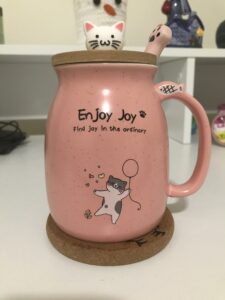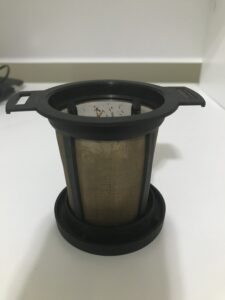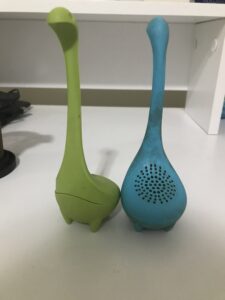I promise I have interests other than tea (an aside: tea-drinking goes rather well with reading and writing, I must say), but as a follow-up to my previous ramble, here’s a quick-start guide to looseleaf tea. This is for anyone who wants to try steeping looseleaf but doesn’t know where to start or lacks the time and brain space to figure it out. This post should also be more organized and coherent than my prior one, ha.
If you prefer tea bags, that’s understandable! They require no equipment, not even an infuser basket. Some of the vendors I list also offer quality tea bags. However, I will focus on looseleaf, as it uses fewer packaging materials and offers more flexibility in serving size and steep style.
The Minimalist Quick-Start
If you have limited cash, time, space, or brain space, you can just put an infuser basket in a mug full of hot water. Here is a more detailed, but minimalist, set of equipment:
- Tea – well obviously. My preferred source is MEM Tea Imports.
- Favorite mug – ceramic works fine (I have this mug)
- Infuser basket – with ample space and fine mesh, fits in mug (I use this basket)
- Hot water kettle – no frills required (I use an electric one like this) – microwave or other method of heating water also ok
- Timer – either your phone or your kitchen timer will do
- Thermometer – critical for green tea, less so for blacks, oolongs, and herbals
- Teaspoon – any standard measuring spoon will work
That’s it. That’s all you need. You probably already have most of it, in which case you just need the basket and tea. You can find details on how to steep tea on MEM’s website. They have a how-to guide for different types.
Here are a few teas I’ve enjoyed:
- green – China Green Jade
- oolong – Tung Ting
- black spiced blend – masala chai (drink with milk)
- spiced herbal – rooibos-based herbal chai (drink with milk)
- floral herbal – chamomile
This list is merely a starting point; I kept it short to avoid overwhelming you with options. If you have known preferences, shop accordingly.
You can stop here, or read on for in-depth recommendations.
Tea Sources
Clearly we require tea. Tasty tea. Delightful tea. All other tea-related equipment is useless without tea. What else are we going to steep, air?
As I said before, my go-to shop is MEM Tea Imports. (To clarify, they have no idea I’m posting this. This isn’t a sponsored endorsement. I just like them.) Their site provides explanations and guidance for both Western-style teapot steeping (which I discuss here) and Eastern-style gong fu cha (which I’d like to try someday but haven’t yet). They also suggest temperatures and steep times for individual teas.
Even if you don’t purchase their tea, I highly recommend perusing their website for the wealth of information it offers. In particular, read their How To Steep article and their articles about white, green, black, pu-erh, etc.
Alternatively, a friend of mine likes Upton Tea Imports. She enjoys blending their blacks with their herbal chais. Upton Tea also has (according to my friend) a program where you can send in your tea tins from a previous order and get them refilled, to reduce waste.
I was once given a sampler of tea pyramids (fancy bags) and a can of loose-leaf Belgian Mint from Tea Forté. They’re a bit pricey, but they may have some blends that interest you. (I quite liked the mint and several of the other sampler teas.)
These are only a few suggestions. Numerous other tea suppliers exist; I just tried MEM, was pleased, and stuck with them. If you have a local shop, check it out! Research other sources if you want. The Reddit tea community has a staggering compendium of vendors.
Tea Types
Okay, now we’ve identified places to get tea. What to get, though?
I’m not going to write a comprehensive explanation of every type of tea, here, just make some quick notes about the categories I’ve tried. But maybe this will help you figure out what you might like to try, if you don’t know.
White teas tend to have very light, delicate flavors. They don’t typically have much caffeine, but, like all Camellia sinensis, they have some. These have actually been a little too light for my tastes to bother with them regularly, but perhaps you’ll like them.
Green teas are plant-y and grass-y. Something like China Green Jade is especially so, and I find that a nice, bracing drink in the morning. Jasmine pearls are more delicate and smell lovely. Watch the temperature and steep time with green teas. I cannot emphasize this enough.
Black teas are also called red teas. They have a stronger but less, well, plant-y flavor. Some of them are best tempered with milk. Others stand well alone. If you’re also a coffee drinker, you might like blacks.
Oolongs are neat because they’re hardier and more forgiving than greens, but not quite as oxidized as blacks. They can resemble a green’s leafy taste while having more depth and complexity from partial oxidation. If you’re intimidated by green’s finickiness but want a leafy or complex flavor, you may do well with an oolong.
Chai literally means tea, but chai blends in the U.S. tend to be black tea blends with spices. Masala chai is a term (and type of tea) that originated in India. It’s basically spiced milk tea. I love chais. Definitely have chais with milk.
Herbals are bursting with variety. Mints are refreshing, chamomile is floral-sweet and soothing, hibiscus is tart and fruity (I did not like this, but others love it)… You have a plethora of options here with wildly different flavors, and all of them are caffeine-free. This is a godsend for anyone who cannot have caffeine at night. (Read: me.)
You might want to get samples to experiment with different types–or different varieties within a type–in a cost-effective way.
Here’s a little tip for steeping, too: for robust teas such as a black or herbal, rinse your mug with boiled water before you fill it and steep. Water loses heat when transferred to a cooler vessel. Pre-heating the mug mitigates the heat loss and maximizes your steeping temperature, which extracts more flavor.
Equipment
Here’s what I use and why I use it. This is mostly equipment from the minimalist list, but with my teapot and teacups added, and with details about each thing.
Favorite Mug
You don’t have to have a favorite mug. Any mug that will let you drink hot liquids safely will suffice. But I have a favorite. Behold:

This mug has a 15 oz capacity and a lid and stirring spoon. It’s my chai latte mug. I always have milk in my chais. (I do not bother with sugar, though you may choose to.) Sometimes I want to have as few dishes to clean as possible. And sometimes I just want to cradle a jar-shaped mug in my hands.
Infuser Basket
I recommend getting one of these even if you do have a teapot, for times you want to steep directly in a mug and minimize cleanup (or just not steep as much tea).
Here’s mine. Apologies, it’s full of used herbal chai at the moment:

If I recall correctly, this is a Finum infuser basket. It was quite affordable for its quality, only $12 at MEM. It also has ample space for tea leaves to unfurl and expand. This is important. This increases the surface area for diffusion and thus lets the water extract more flavor from the tea.
Additionally, the wire mesh is very fine. Water passes through, but the mesh traps particles that some infusers with larger holes would let escape. (Note: not fine-sediment-proof. I haven’t noticed sediment with whole-leaf teas, mostly just certain spiced blends, and I’m not fussed either way. But if even traces of fine sediment bother you, you might try paper filters.)
It is also easy to use and consumes minimal storage space. The lid that traps heat for steeping doubles as a tray for the basket, once the tea is done.
If you’re using a mug and tea infuser, you probably want something like this: ample room, convenient to use and store, fine enough a mesh to trap tea well.
I also have these Nessie infusers and they are adorable, a gift that delighted me and that I will always be grateful for, but I’d like to contrast them with the basket infuser and point out some practical shortcomings:

They have less volume for the leaves to expand in, and they have limited permeability, so water doesn’t flow through the tea leaves as much, which means less flavor. If the joy they spark outweighs their functional shortcomings, by all means enjoy them! I certainly did, before the basket. Just be cognizant of their limitations.
Teapot (And Cups)
That being said, teapots have their advantages too. One, they’re lovely. Two, pouring from a teapot into a smaller teacup will make that portion cool to a drinkable temperature quickly, while the rest stays warm in the pot. Three, they are ideal for sharing with friends, assuming a sizable pot.
For most people, ceramic teapots serve well: they are easy enough to clean and insulate extremely well during the steep. Borosilicate glass insulates slightly less well, but passably, and is both pretty and phenomenally easy to clean.
Behold, my teapot with accompanying cups (and tea bags):

This is from when I first acquired the teapot and teacups, along with those three tea bags. The teapot is a Hario with a 700 ml (~24 oz, or two midsize mugs) capacity and cost me $25. The two teacups were $12 each. All this teaware is made of borosilicate glass.
I gushed about this teapot at length in my prior ramble, but in summary, I like both its aesthetic and its practicality: it’s cute and elegant, easy to use and clean, and well designed. The round shape helps with heat retention, and the removable basket is convenient, roomy, and a fine mesh–almost, but not quite, as fine as my mug infuser.
Size-wise, it doesn’t take excessive storage space and can serve one or two people comfortably. If you don’t plan to split pots with friends, an even smaller tea pot might do fine for you, but I do like sharing.
The teacups have similar advantages to the teapot: pretty, easy to clean, resilient to dramatic temperature changes. Note, they don’t have handles, and they can get hot to the touch. But I consider this a feature, not a bug. If the cup is difficult to pick up, the tea will scald my mouth. If I can lift it, its contents have cooled enough to drink (but can still be quite warm!).
Hot Water Kettle
I’m getting too lazy to add pictures at this point, but I have an electric kettle that my college roommate left me. Comparable ones are less than $25. It doesn’t have bells and whistles–no temperature controls–but it has a 1.7 liter capacity, is simple to use, and lets me see the water roiling through the glass. I do enjoy watching the water roil. From a more functional perspective, I also like being able to know how much water is left at a glance.
Of all the equipment I use for tea, this consumes the most space. But honestly? Worth it. It’s not just good for tea. (Or other beverages.) It’s also good for cooking. I use it to quickly heat water for a pot of soup or boiled eggs.
You can get a fancy one with temperature controls, or you can do what I did and just get one more thing…
Thermometer
I mean a cooking thermometer. The kind you can stick in a liquid in the kitchen. Maybe you already have one. Mine’s just a long, narrow metal rod with a digital readout at the base and an on/off button. Unexciting, but useful. Critical if you’re steeping green tea. An oversteeped pot of green brings regret.
Oh right. One other thing…
Timer
I had issues with my cell phone not making sound sometimes, for some reason, so I got a simple digital kitchen timer. But your phone may suffice. As long as you have a reliable alert system for when your tea is ready.
Oh, and another thing I suppose:
Teaspoon
I have a metal measuring spoon specifically for tea. I like it because it has a round, deep scoop. But really, any measuring teaspoon will do. You probably already have one in your kitchen.
…and that’s all!
This post is quite long. I think I covered everything I wanted to cover in a coherent enough fashion, so I’ll conclude it here.
Get yourself a mug of tea, a blanket, and a good book. Or series of books. All the books. Or a notebook to scribble stories in. Either is an excellent accompaniment to teatime.
Happy tea drinking!